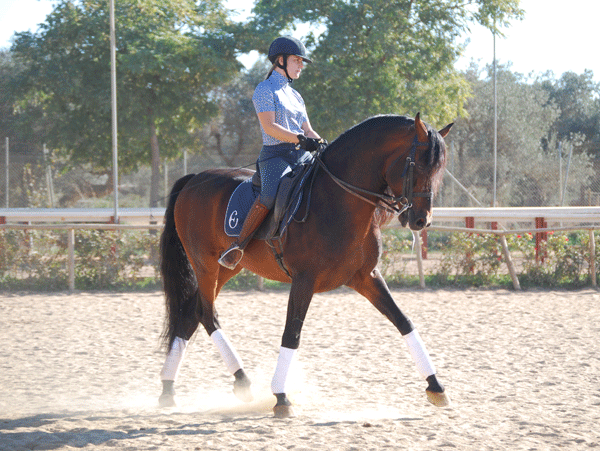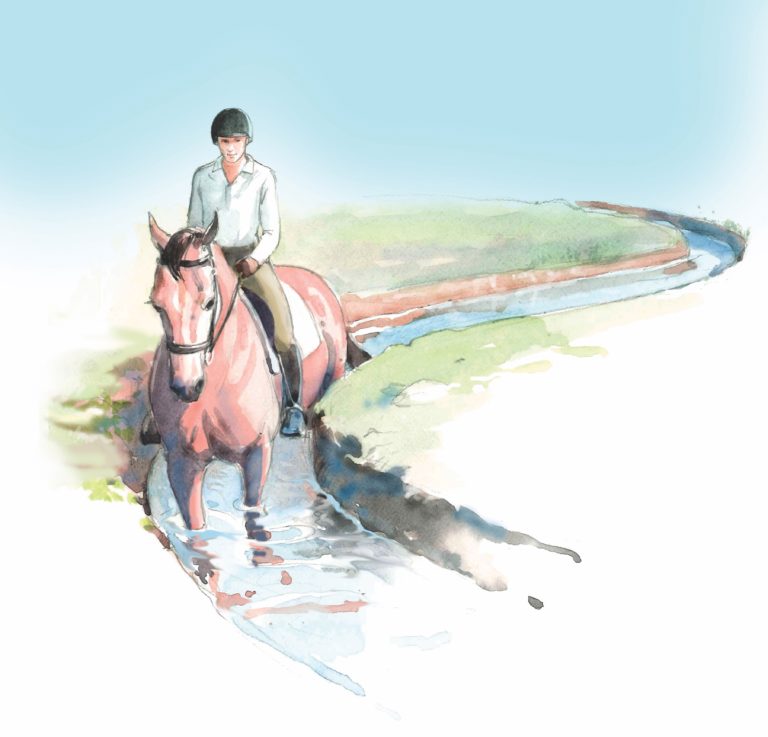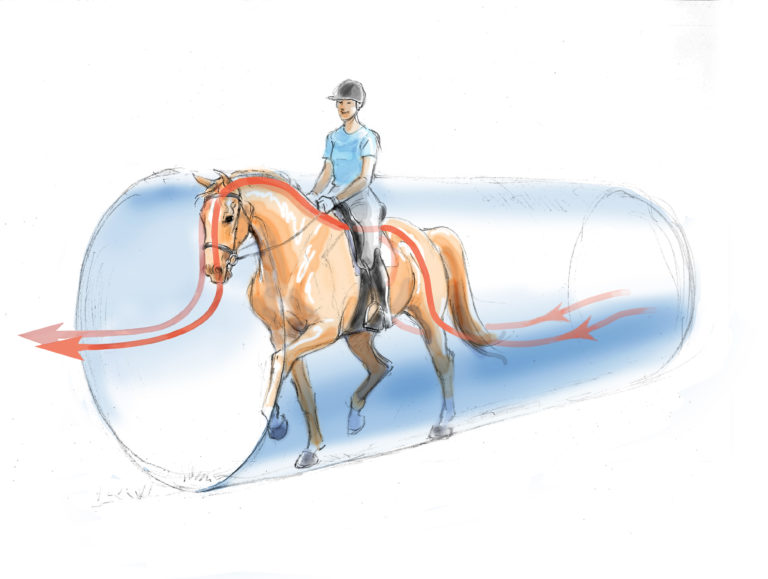
Nestled in the beautiful Spanish countryside outside of Seville in Carmona is a 16th-century hacienda that is home to Epona Equestrian Center—a world-class British Horse Society-approved facility named for Epona, the goddess protector of horses in Celtic mythology. Fernando and Jane Garcia founded the horse farm and training facility in 1985 and still own and operate it today. All of the instructors are accredited by the British Horse Society and the Spanish Equestrian Federation under the direction of their daughter Catalina, “Caty,” chief instructor.
Another daughter, Viviana, “Vivi,” Garcia, an instructor and master trainer at Epona, specializes in training the Pura Raza Español (P.R.E.)— the noble Andalusian horse breed that was established in the 1500s in southern Spain. A graduate of the four-year training program at the prestigious Royal Andalusian School of Equestrian Art in Jerez, Garcia was taken under the wing of Rafael Soto soon after he and the Spanish dressage team earned a silver medal at the 2004 Olympic Games in Athens. This was Soto’s third Olympic Games, and his international experience added to Garcia’s training.
“I learned Rafael’s method to train a horse, which is very clear,” Garcia says. “Probably the most important thing he taught me is the feeling of rhythm, balance and straightness the moment it is asked for and the importance of the basics of each gait.”
Though she currently does not have a competition partner, Garcia trains all horses with a direct competition focus. Many horses trained by Garcia and sold at Epona are competing today. Most notably, she started the P.R.E. stallion Marques XXXVI and trained him for six months (including passage, piaffe and flying changes) before he was sold to Rhea Scott, a California resident who had taken a riding vacation at Epona. The horse went on to be namedthe USDF Pura Raza Española Horse of the Year in 2012 and 2013 Horse of the Year at Prix St. Georges with trainer and rider Sabine Schut-Kery (see “Arena,” p. 16).


Riding and Training Spanish Horses
Strong, intelligent and quiet-minded horse, P.R.E.s usually stands 16 to 17 hands and are shorter in the back than many breeds. Because of their compactness, their neck conformation and the natural, proud way they carry themselves, P.R.E.s typically are not difficult to collect.

“P.R.E.s are eager to please and like to work,” says Garcia. “They learn quickly, and all levels of riders can enjoy them. In training, riders tend to block Spanish horses and override them, especially when they are accustomed to riding warmbloods and other breeds that often are harder to collect. If overridden, Spanish horses stop going forward. They generally need a more sensitive style of riding because they are sensitive, willing and sometimes give more than they are asked for.
“Another thing that I must mention about P.R.E. horses is that if they are trained well, they constantly evolve and get better,” says Garcia. “The natural movement and reach that they have as youngsters tends to slowly improve and get bigger as they mature. This shows well in the half pass.”
Adding Power Behind
P.R.E.s don’t typically have a lot of natural power in their back end, Garcia says, but that can be developed. One thing she has realized over the years (especially after training with Soto) is that every horse has room for improvement, sometimes much more than we can imagine.

“If trained properly and consistently, a horse develops enough muscle, power and balance to become a better dressage horse,” says Garcia. “Even the way a horse looks will radically change with dedication to careful training. Conversely, I have also seen talented horses with a natural ease for dressage and who are using the hind end correctly deteriorate because of bad training methods.”
To build muscle and power in the hindquarters, Garcia depends on lateral movements. “They greatly improve elasticity and reach,” she says. “You will also find that by riding a lot of lateral exercises, balance and contact will improve. Exercises such as shoulder-in and counter shoulder-in on a 20-meter circle accentuate the crossing and stepping under of the inside hind leg, which develops power and elasticity.
“Travers on the circle is also good, though it is a little more demanding for the horse,” Garcia continues. “So do not expect too much inside bend and do not hold the exercise for too many steps. It is important not to overface the horse, especially when shoulder-in and travers on the circle are new to him. These exercises should be introduced progressively. If ridden correctly, they tend to make the horse light in front.”
When riding and training, Garcia’s half halts never last more than a few strides and are immediately followed by a softening of the aids (especially the rein aid). “The horse learns to sit back, shift his weight to the hind end and become light in front,” she explains. “This is a great time to work on the stretching of the topline. Combine exercises like shoulder-in and travers [right and left] and half halts all on the circle, and then ask for a long and low stretch. Stretching is a priority if you want to get your horse over his topline, and it is also essential to developing self-carriage. If you work on building the muscles and the suppleness of the topline, you will have a better chance that the horse’s hind legs will step more underneath his body.”
Garcia includes walk pirouettes, leg yields and transitions between gaits and within the same gait during warm-up to improve and develop the correct use of her horse’s hindquarters. “The combination of all these exercises is what we call ‘gymnastics’ because we are developing the stretch, the elasticity, the muscle power and the suppleness in the same way that a gymnast would,” she says. “A horse that feels the movements become more and more easy as the body prepares to do what we are asking will be a trainable, more willing and happier horse altogether.”

When asked about training half pass with a P.R.E., Garcia responds, “There really are not many differences in the way that you ride or train the half pass with a P.R.E. horse. It depends on the horse. Some P.R.E.s have more elasticity and move laterally more easily than others, which is the case with all breeds. But you can always improve the quality of a half pass if you first develop a horse’s physical potential by training with a lot of gymnastics.”
Though not included in competitive dressage, the elegant Spanish walk wonderfully complements and exaggerates the innate carriage of Spanish horses. It is steeped in hundreds of years of Spanish riding tradition and is still trained, practiced and performed today.
“I don’t really know why the Spanish walk is not included in competitive dressage,” Garcia says. “But it is our Spanish riding tradition and we have been doing it for centuries so we did not drop it. It will not cause any training conflicts for a horse. In fact, it is helpful for stretching of the shoulder and front legs, developing elasticity and, when properly executed, it helps slow down the rhythm of the walk, enabling the horse to bring his hind end more underneath his body.”

In 2004, Garcia applied for a coveted spot in the four-year training program at the school. In addition to the written entrance exam, she was required to ride a Fourth Level dressage test on a school horse she had never ridden before. She scored a 96 (the second-highest mark in the tryout) and was accepted with great enthusiasm.So began the journey that led Garcia to the masterful tutelage of Rafael Soto. After completing two years of the royal school’s program, she was taken under Soto’s wing. She completed the last two years training with him daily until graduation in 2007 when she received the high honor of being named “jinete” (rider). “I shared a lot of knowledge with Vivi, but she always had a natural ability for riding,” says Soto. “When she was at the school training with me she improved every day. Now she can train horses one after another and does exceptionally well with young horses in a very short time. She has developed a great system and can work alone here at Epona and get the best out of the horses. I feel proud every time I see her ride.” When asked why he thinks Garcia is such a wonderful trainer, Soto says with a smile, “Why does she train so well? She was in school with me!” Garcia will echo Soto and tell you that he was the one who trained her to train horses. Soto’s method includes the philosophy that with every problem there is a solution and that the foundation work is the most important. “It is important to know why something doesn’t work,” he says. “You need to be able to analyze it. If you can’t analyze the problem, how can you find the solution? With every pupil I teach, I learn something. They teach me how to teach them. I always learned from Vivi. I always admired her enthusiasm. You must have that feeling inside your heart like Vivi does to train so many horses.”Today, Soto and Garcia continue their mentoring and training relationship at Epona instead of at the royal school. They often work in tandem with students and horses during Soto’s clinics there, and he also occasionally does some training with Garcia. “When I have time, I give her some advice. You never stop learning with horses.” “I get a lot of enjoyment out of training and it is a thrill for me to watch people on horses I have trained,” says Garcia. “It is good for a rider to compete, but for now my main focus is on what we do here
at Epona.” Special thanks to the Garcia family and the staff at Epona, Rafael Soto, the tourism office of Seville and Kerrits equestrian apparel. For more information, visit eponaspain.com, sevilla.org, andalucia.org and kerrits.com.
Vivi Garcia’s passage from student to master trainer began in childhood. Her father, Fernando, competed in show jumping and mother, Jane, trained in dressage, so it was inevitable that horses would become an integral part of Garcia’s life as well. She began riding when she was 3 and was successfully competing at the age of 10 in various disciplines and levels. She excelled at jumping ponies, earning numerous gold medals.
Garcia followed in her father’s bootsteps, show jumping became her passion. After high school, she bought an Andalusian–Thoroughbred cross that was not a good candidate for jumping, so she set her sights on dressage. She took lessons from Jose Maria Sanchez Cabos, then technical director of the Royal Andalusian School of Equestrian Art in Jerez, Spain, who came to Epona weekly for many months.
In 2003, Sanchez Cabos encouraged Garcia to take a course at the Royal Andalusian School. Over the years, her father had been making weekly trips to the school with Epona guests to see the performances, and her sister Caty had also trained there, so she was eager to follow up on Sanchez Cabos’ suggestion. After Garcia was accepted for a two-week course, she exclaimed to her father: “Dad, this is going to be my universe!”











